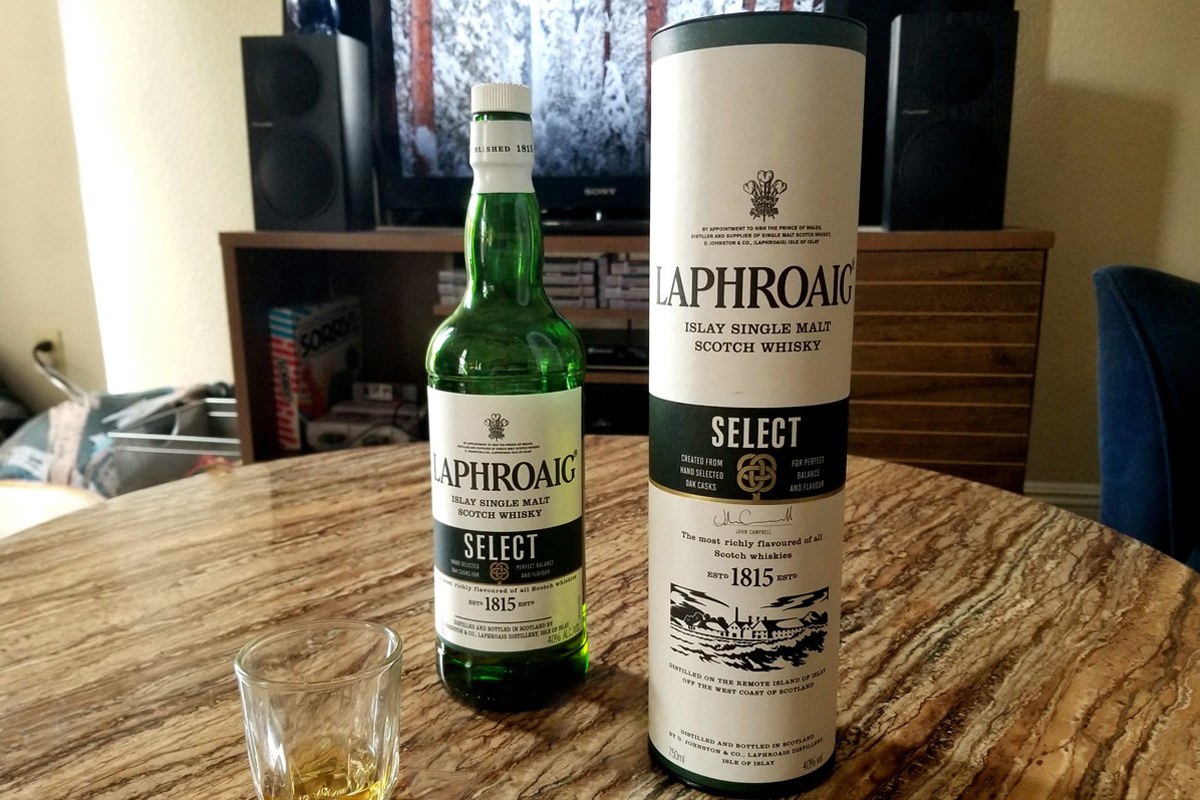Let’s get two things clear:
- Your objective is to drink the best Scotch whiskeys under $250.
- Our objective was to find them.
The hunt was difficult: Scotch whiskey is immensely varied, idiosyncratic, and personal. Perhaps, for instance, you prefer a deep-bodied whiskey with dark fruit, figs, and butterscotch on the tongue. In that case, the best Scotch whiskey for you may be Balvenie 21 PortWood, the crown jewel of venerated Malt Master David C. Stewart. Or maybe you prefer a crackling, bright peaty affair: in that case, proceed to Laphroaig Select and never leave the Isle of Islay.
The beauty of drinking Scotch is in its intimacy — the most likely thing you’ll encounter at the bottom of a bottle is yourself. Finding the “best” Scotch is not like identifying the team that won the Super Bowl or putting the item that gets the most stars in your Amazon cart. Instead, it’s an exploration of values, taste, and personal aesthetics. I mean, it’s about getting drunk, right? The whole point is to displace ordinary experience and launch into the mystic. A bracing Scotch whiskey is a worthy copilot for sailing the unknown.
(Note: One way to think about that introduction is that it kicks off a subjective review to the best Scotch whiskeys under $250. Another way to interpret it would be: It’s a disaffected, poetic copout that steers well clear of the article’s self-announced purpose.
I’ll let you decide. I’m going to test some more affordable Scotch.
The Best Scotch Whiskey Under $250
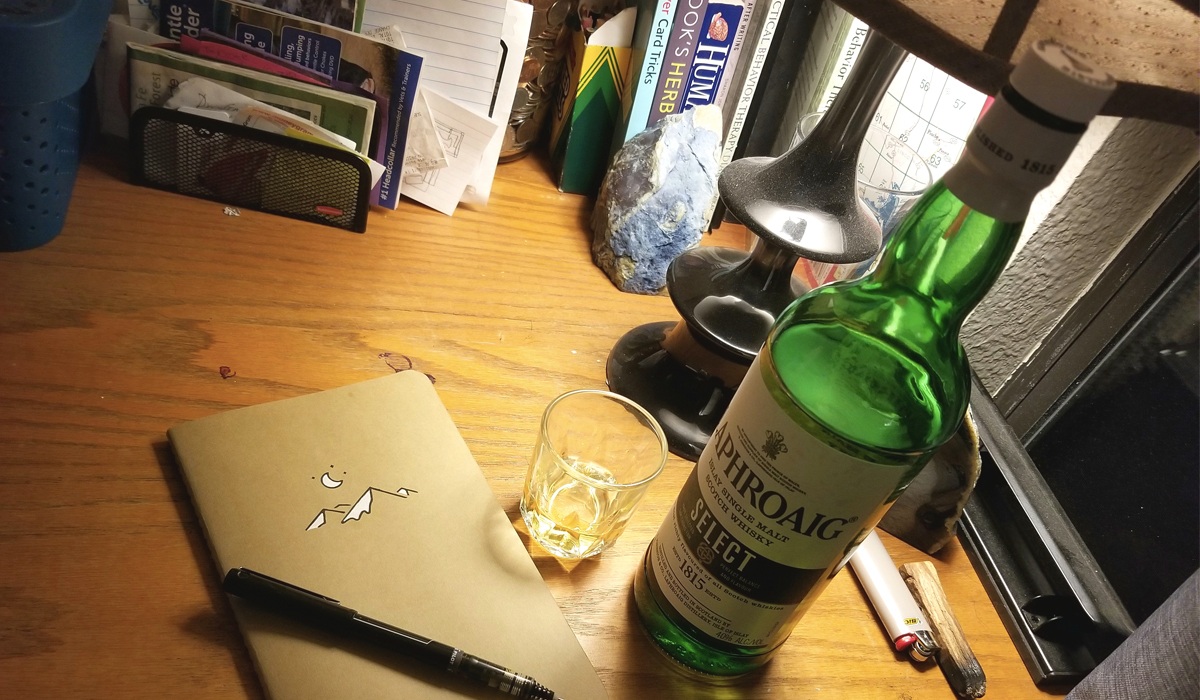
Laphroaig Select Single Malt Scotch
Laphroaig Select single malt Scotch whiskey, distilled for over 200 years on the Isle of Islay, is a lively spirit. Pungent, peaty, and smoky, it sparkles over the palate like hoary mist over hot coals. (You might not want to take that as plain fact — I’ve been drinking Laphroaig).
Laphroaig has been my go-to single malt since I was too young to (legally) drink. I’ve always favored it due to its directness and simplicity. Of course, this is how I perceive it. The trick with Scotches is their ability to transform across various palates. Refreshingly, Laphroaig itself declines to lead its customers by the bit of expectation.
In fact, the distiller’s website features a, dare I say, hilarious — yes, I will stake my journalistic claim to that vocabulary — hilarious video of a local tasting tour conducted on the Isle of Islay in celebration of its 200th anniversary in 2015. The backdrop is replete with quaint island scenes and browsing sheep. The point is to give people Laphroaig and record their candid reactions. One older gentleman, holding a well-worn walking stick and a glass of Scotch, proclaims, “it tastes just the same as it was 200 years ago.” Read that again. Elsewhere, two women liken it to “hell” and “a wet bog.”
Tremendous. And there’s only one way to find out for yourself! What could be more adventurous?
Laphroaig Select is the distiller’s entry-level whiskey (don’t judge — writing makes some money, but I’m pretty far from a personal Scotch collection). However, in my opinion, the bottle is the best affordable single malt Scotch out there.
Laphroaig doesn’t bend over backward to quantify the effect of its own product. Instead, it lets Select make its own impression, noting only the spirit’s distinct “peat reek.”
Laphroaig bottles many spirits — I have had the opportunity to imbibe the 25 Year Old, which I found magnificently bracing, but it’s well out of our price range. For around fifty bucks off the shelf here in the American wild west, Laphroaig Select is a singular delight for adventurous spirits.
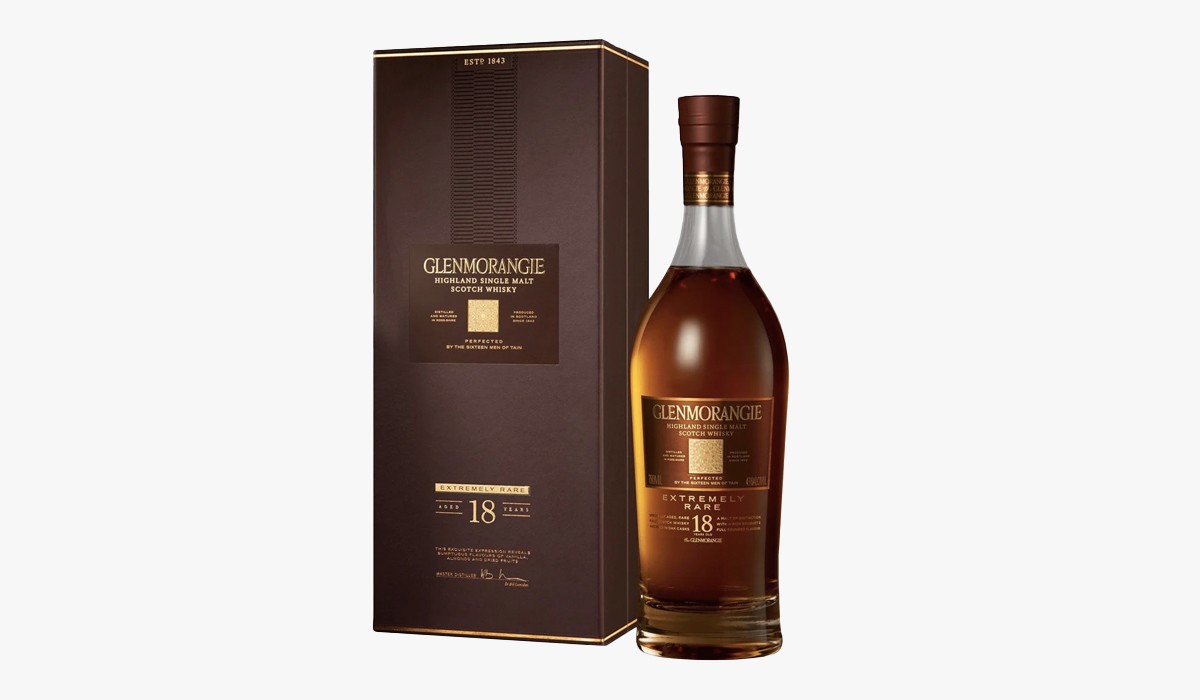
Glenmorangie 18 Year Extremely Rare Scotch Whiskey
Glenmorangie 18 Year Extremely Rare Scotch whiskey spent its first 15 years in American white oak bourbon barrels. After that, distillers at Glenmorangie transferred a fraction of it to Oloroso sherry casks. At the 18-year mark, the single malt was recombined and bottled.
Oloroso means “scented” or “fragrant” in Spanish — a more literal translation could suggest “smelly.” Many tasters note a fruity or floral impression from Glenmorangie 18 Year Extremely Rare, which could owe to its fragrant cask finishing.
Glenmorangie imbues the 18 Year Scotch with Lucy-in-the-Sky psychotropic, musing “[t]he last hours of a perfect autumn day when the world looks like a golden dream filled with cookie-coloured leaves and butterscotch skies…What would that taste like?” To clarify, the product is whiskey, not ice cream, and if you’re confusing the two, you’ve probably had plenty.
MSRP is not available, but the market price for Glenmorangie 18 Year Extremely Rare Scotch is under a hundred and fifty bills. You may also be interested in these top-quality whiskeys from Tennessee from our list. Check them out.

The Glenlivet 18-Year-Old Scotch Whiskey
The Glenlivet uses first and second fill American oak barrels (for “tropical fruitiness,” it says) and sherry oak barrels to add “spicy complexity” to its 18-Year-Old single malt Scotch. The 18 Year Old enjoys a sterling reputation among The Glenlivet’s wide-ranging offerings.
The Glenlivet is immensely storied and well-established. Its founder, George Smith, applied for a distilling license in 1823. It wasn’t a popular decision among the whiskey outlaws of the time, and legend has it that he immediately started carrying two pistols to settle differences. The scrappy Scot made it, though, and his brand is now the second most popular Scotch whiskey in the world.
Its 18-Year-Old single malt, conceived by Master Distiller Alan Winchester, stands testament to the strength of the Glenlivet tradition. Not overly smoky or peaty, its distinct fruit should please many, and the depth of its flavor makes it well-suited to drink neat. Glenlivet declines to give an MSRP, but the 18 Year Old’s market price is generally regarded as low, considering its quality and pedigree — it could be the best Scotch whiskey under $200.
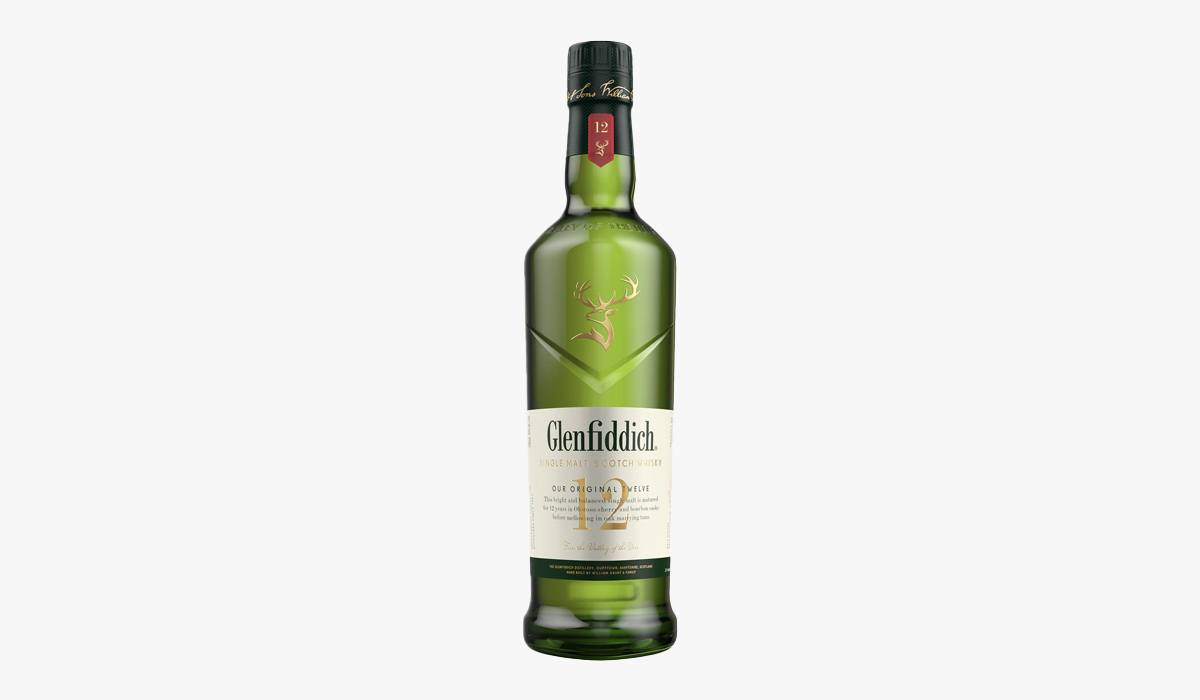
Glenfiddich 12 Year Old Scotch Whiskey
Widely available Glenfiddich 12 Year Old is a standby Speyside Scotch that comes at a reasonable price. Glenfiddich, distilled in the “Valley of the Deer” since 1887, delivers a consistent and renowned product in its 12-Year-Old Scotch.
The distiller touts spring water and a “high cut point” as keys to the 12 Year Old’s fresh and fruity character. William Grant, Glenfiddich’s founder, introduced the high cut point technique. A distiller “cuts” their product when they switch the container of distillate, catching the flow of alcohol from the still as it rises in temperature. A higher cut-point means they wait for a higher temperature before cutting — resulting in more purity.
Glenfiddich spreads its 12 Year Old Scotch far and wide. It’s one of the best value Scotches that one can find at many liquor stores in the United States at an easy-to-swallow (har har) market price.
There are complaints that the plastic stopper was inadequate (I might consider any plastic stopper inadequate for single malt Scotch). However, as a Laphroaig drinker, I can’t confirm or disconfirm whether Glenfiddich still uses it. Let’s face it — as a last resort, you can always drink the whole bottle at once. Take a look at some of the top rye whiskey brands from our list, and pick the one that suits you the most.
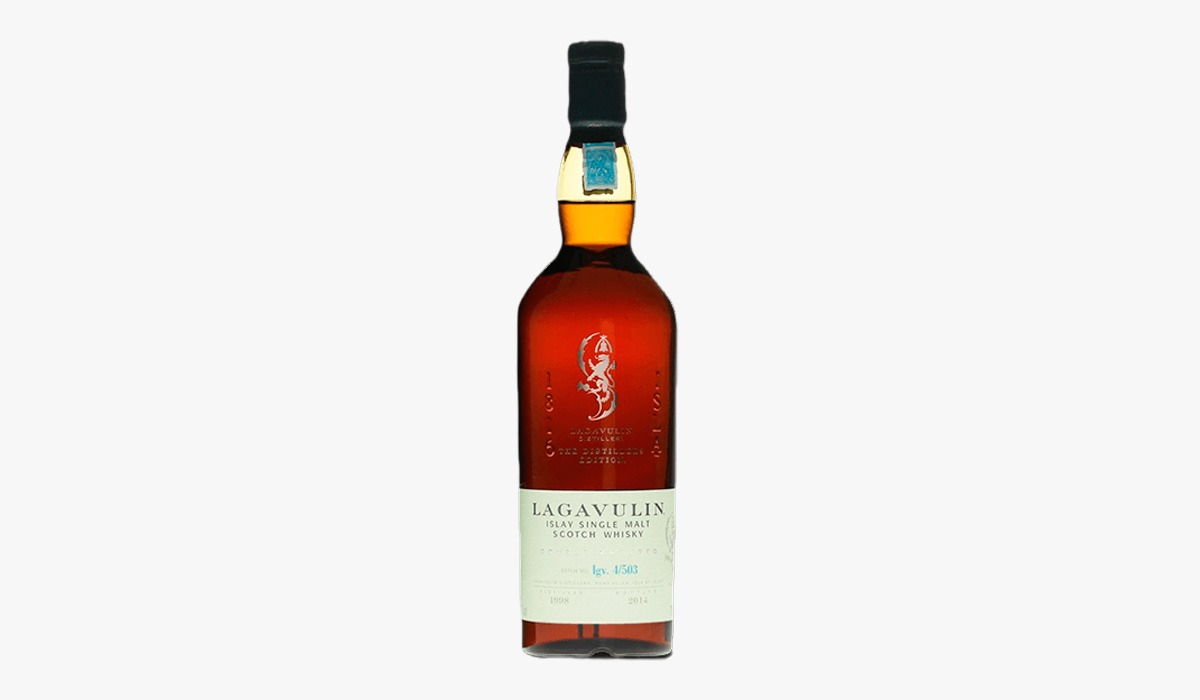
Lagavulin Distiller’s Edition Scotch Whiskey
I knew I had to include Lagavulin’s Distiller’s Edition in our list, so I set about learning what I could. I’m not sure whether the best way to research the Islay distiller’s whiskey (other than drinking it) is to watch YouTube videos of people drinking it, but it’s definitely my favorite way.
From such videos, I’ve learned that it’s double-matured. One reviewer says: “So am I. I matured once, and then I was like…I’m gonna do that again.” He means that Lagavulin Distiller’s Edition spends years maturing in its original oak barrels and then gets transferred to Pedro Ximenez sherry barrels to finish. The technique makes the Islay Scotch’s core sweeter than most of Lagavulin’s typically smoky entries.
In all, Distiller’s Edition spends 16 years aging before dark amber gluts of it funnel into the bottle. One man describes that it tastes like “a cigar; salt-water with roses sprinkled on top.” I once drank a cigar, but it was inside an errant Dr. Pepper can I mistakenly chugged from while trying not to vomit after taking a shot of God-knows-what at a party in high school. I’m sure “cigar” tastes much better in Lagavulin’s bottles.
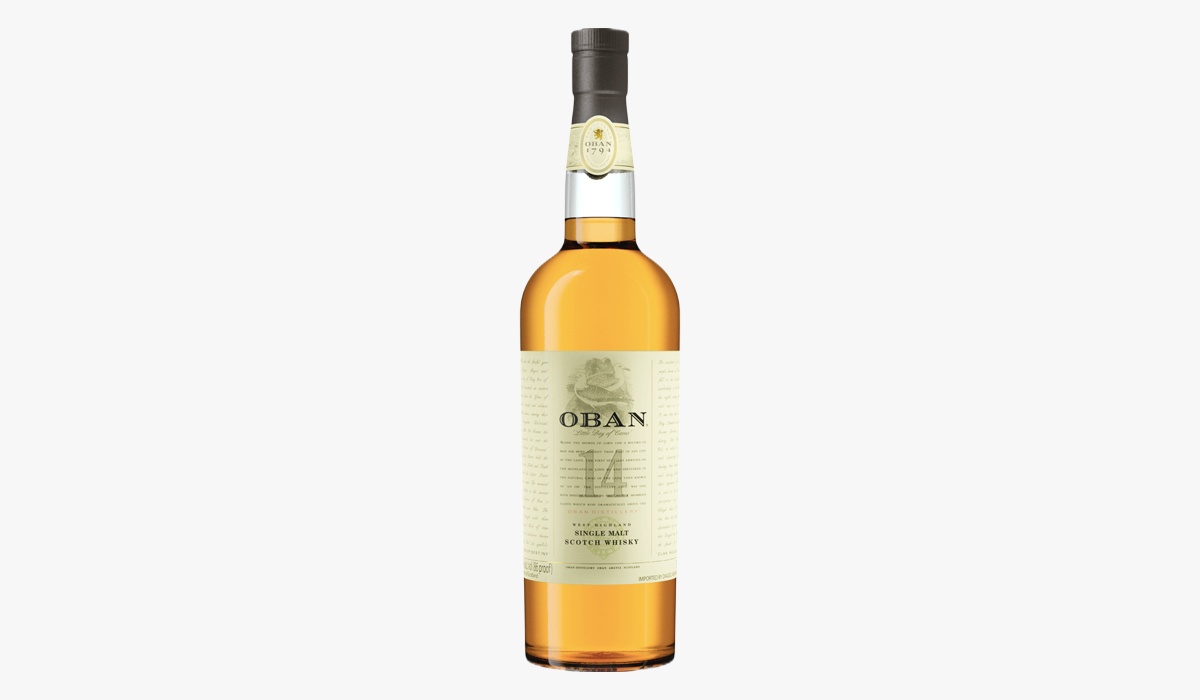
Oban 14 Years Old
You might think that the Oban distillery is named after the town of Oban, Scotland. Instead, it’s the other way around. Established in 1794, Oban takes well-earned pride in its status as one of Scotland’s oldest and smallest distilleries. Its 14-Year-Old whiskey is its entry offering but is highly rewarded and has established a reputation for quality. A moderately sweet palate and smoky finish characterize the spirit.
The distillery named after the “Little Bay” is all about tradition. Only three distilleries in Scotland are older than Oban, but none is smaller: its entire property covers one acre. And because Oban still uses traditional methods, it produces its whiskey in limited quantities as a matter of course. The distiller explains its process with a cool, straightforward list of illustrated facts under the “Heritage” tab on its website.
That brings us to Oban 14 Year Old, which is aged in American white oak barrels. It uses water from a loch three miles from the distillery. It’s known for being sweet but not too sweet, with moderate peat and oak flavors plus an acidic finish to balance its more lush flavors.
Though Oban is the epitome of a boutique distillery that offers a time-tested product, it makes its whiskey accessible: no MSRP is available, but a bottle of Oban 14 Year Old costs less than $100. It can be a cool gift for men who enjoy a nice drink from time to time.
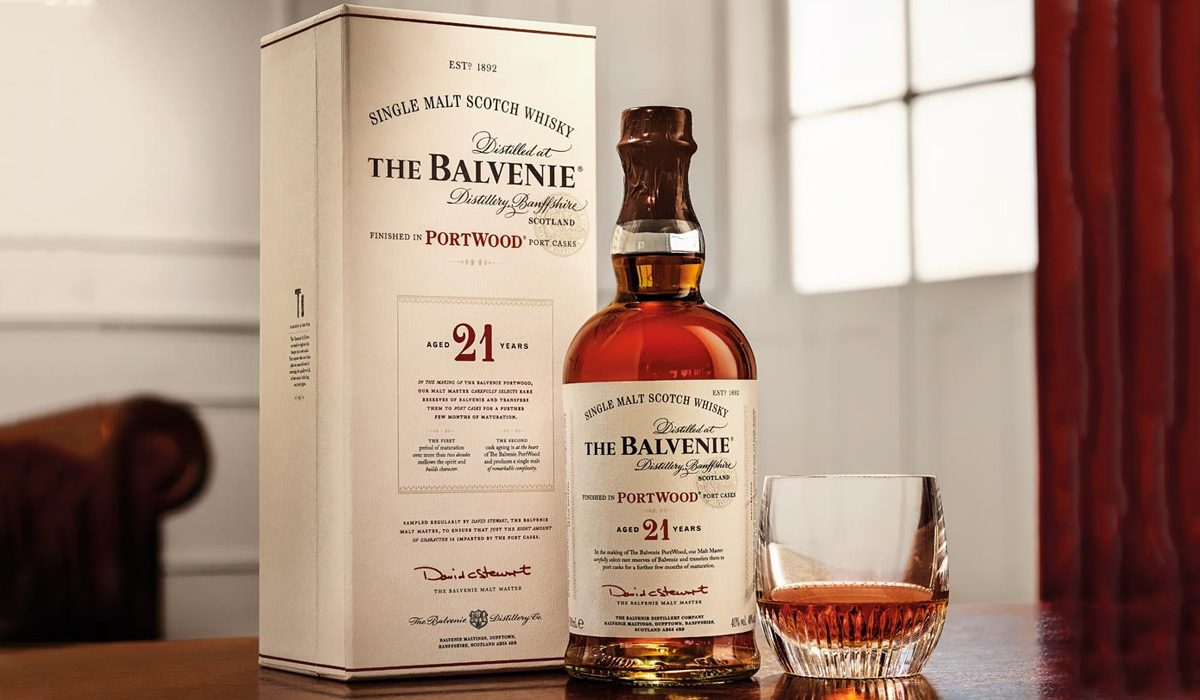
The Balvenie PortWood
The Balvenie’s malt master is David C. Stewart, a legendary distiller with 54 years in the industry. To illustrate his stature in the industry: Queen Elizabeth II saw fit to award the man with the third-highest honor possible in the British Empire, the MBE. Stewart is credited with a profound impact on today’s distilling techniques, and The Balvenie regularly cranks out top-rated Scotch whiskeys under his direction. Some consider The Balvenie PortWood 21 to be Stewart’s finest creation.
The single malt takes its name from the port casks it’s finished in. Port wine is distinctively more alcoholic and stronger in flavor than most wines, and it delivers a distinct flavor to PortWood 21. Stewart, who “didn’t expect to become a Malt Master” at The Balvenie when he started as a stock boy in 1962, samples PortWood 21 regularly to ensure the port’s effect (according to the website).
I’m sure Stewart also samples the master-quality Scotch in his duties as a servant of Her Majesty The Queen, but I doubt those are the only reasons he does it. If I could get it for free, I don’t know if I’d ever come out of the cask room.
But 54 years of Scotch-making experience don’t come cheap: The Balvenie does not offer an MSRP, but PortWood 21 might be the best Scotch under $300. For more not so pricey but still quality drinks, check out our list of the best bottles of whiskey under 50$.
Bunnahabhain 18 Year Old
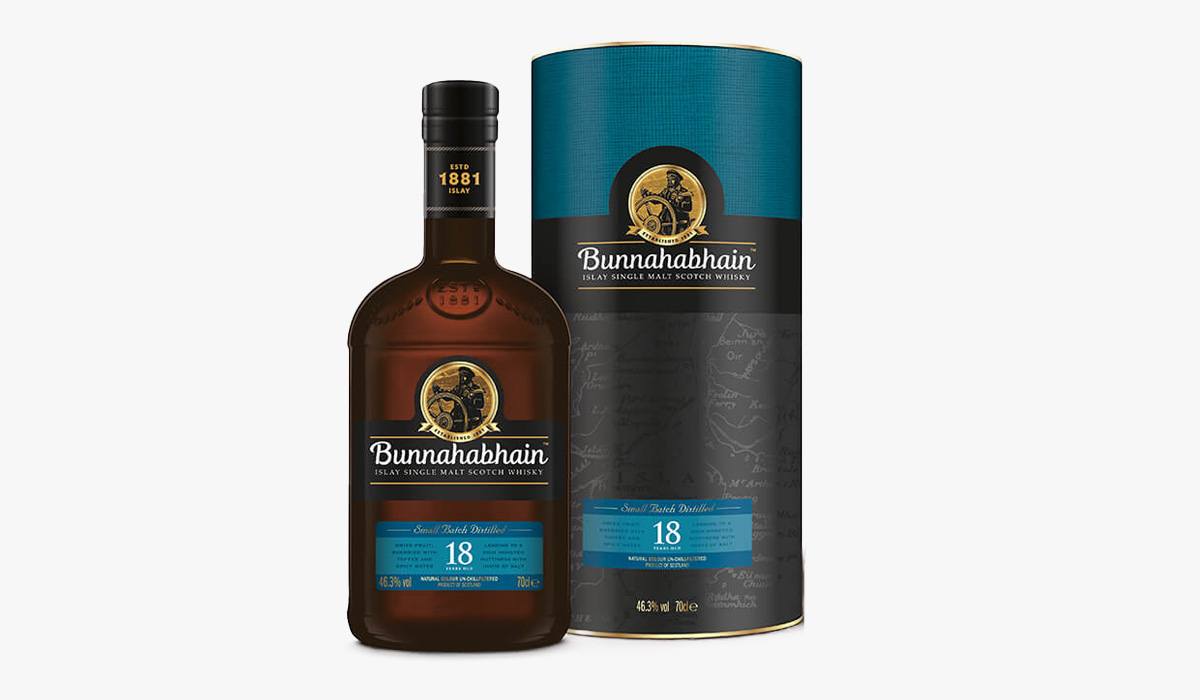
Bunnahabhain 18 is the only Scotch on our list with enough cultivation to provoke its distiller into using the descriptor “rich mahogany.” Yup, Bunnahabhain actually says that on the slug description on its website. Naturally, I was intrigued.
Bunnahabhain’s 18-Year-Old Scotch is widely awarded. The seaside distiller, situated on the isle of Islay, Scotland, notes flavors including toffee, sherry, and oak, with an appropriate hint of sea salt at the finish.
The distiller categorizes the 18 Year Old as “intensely warming.” The single malt is non-chill filtered, meaning naturally occurring sediments like enzymes and protein chains give it a slightly cloudy appearance in the whiskey glass.
Even though I have many plastic-molded video-game cartridges instead of leather-bound books, and my apartment smells of cheap American beer, I’m enticed by Bunnahabhain’s rich mahogany grog. The 18 Year Old Islay whiskey could anchor any drinker’s collection at a moderate price point.
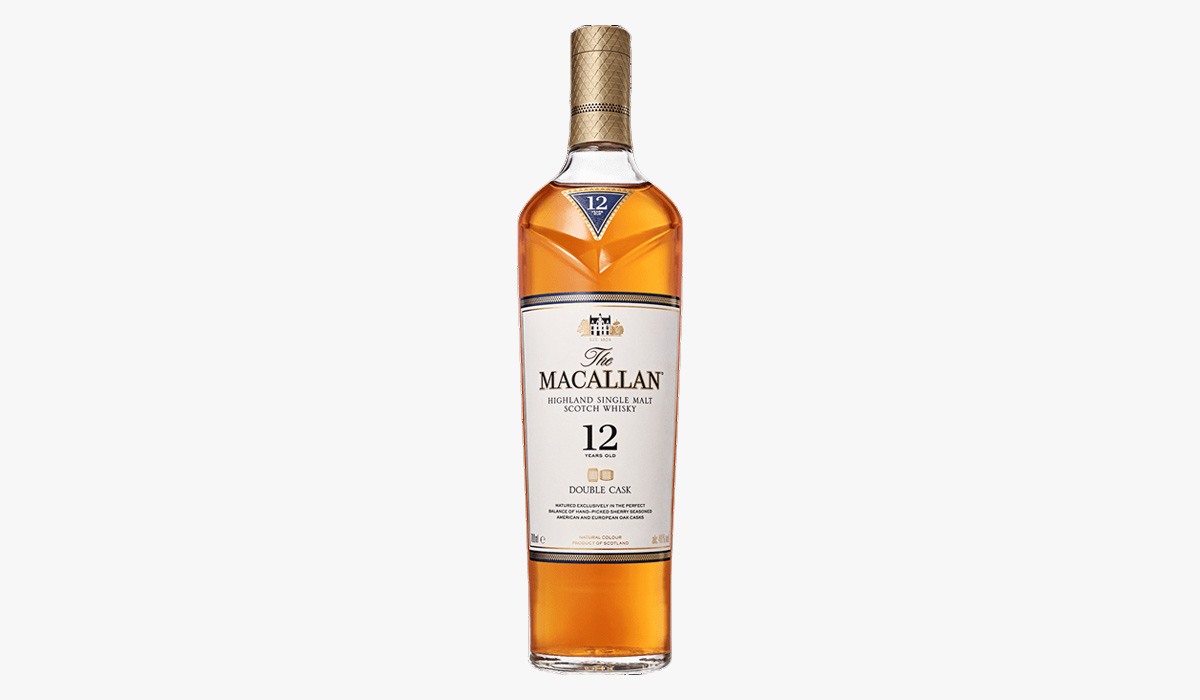
The Macallan Double Cask 12 Years Old
The Macallan is known as a quintessential distiller of sherry oak barrel-aged whiskey. Scotch distillers often use sherry barrels to add flavor to their final product that’s not strong enough to overpower the whiskey. Macallan’s Double Cask 12 Year Old is a moderate and available sherry-finished single malt highland Scotch whiskey.
The Macallan’s reputation as a drinkable Scotch without a heavy peat flavor influences its wide popularity. The distiller’s products are often called “rounded” or “smooth,” or those terms’ deprecating cousin, “middle-of-the-road.”
One standout flavor many of The Macallan offerings, but especially in the Macallan Double Cask 12-Year-Old, is butterscotch. The distiller, as well as many testers, also mention honey. Oloroso sherry enhances the flavor bouquet. The Scotch is a moderate color, dubbed “harvest sun” by The Macallan.
Macallan recommends drinking Double Cask 12 Year Old over an ice ball or in a Pasa Doble with hints of sherry, salt, and maple syrup. For more quality drinks, please browse our selection of these hight proof whiskey bourbons.
Scotch Whiskey Under $250 Buying Guide and FAQ
Features to Look for in Scotch Whiskeys Under $250
Region — On your personal quest to find the best Scotch brands for you, it might help narrow down a region that tends to produce whiskey with your favorite flavor profiles. It’s possible to identify five such regions within Scotland: Highland, Lowland, Speyside, Campbeltown, and Islay. Each region is known for producing whiskey with its own unique, identifiable character (though lines almost always blur). In general:
- Highland: A massive region encompassing many influences and varieties of Scotch.
- Lowland: Lowland Scotch often takes on a softer, smoother character. The Scotch Whisky Association identifies grass, honeysuckle, cream, and other flavors for the region.
- Speyside: The region surrounding the River Spey, known for its fertile glens and fruity, full Scotches. Many Speyside whiskeys are matured in sherry casks.
- Campbeltown: A small, peninsular region known for particular scotches with smoky, salty, fruity characters.
- Islay (pronounced eye-luh): A tiny island, famous for its knockout-strength, peaty, smoky whiskey.
Aging — Whiskey only ages in the barrel (not in the bottle), so barrel aging is critical in the Scotch distilling process. Oak barrels are a fixture. Some Scotches incorporate ex-bourbon barrels and barrels seasoned with sherry or port wines to add flavor.
Single Malt or Blended — “Single malt” means that all the whiskey in the bottle came from the same distillery. That distillery may unite the contents of different casks to make one spirit. Single malts are generally higher quality than blended whiskeys, which are diluted with cheaper spirits or other ingredients.
Nose/Scent — The first thing that happens when you open a bottle of Scotch is that you smell it. It’s part of the experience — breathe it in!
Palate — The flavors and characteristics of whiskey (or anything) while it’s in your mouth. Many seasoned whiskey drinkers hold mouthfuls or even “chew” (yes, chew) Scotch to let flavors continue to emerge. I recommend playing with the technique, but do it for too long, and your mouth will go numb.
Finish — The flavors and characteristics of whiskey after you’ve swallowed it. The finish is important because, let’s face it, you can’t drink forever. Good or bad, every spirit leaves an impression in its wake.
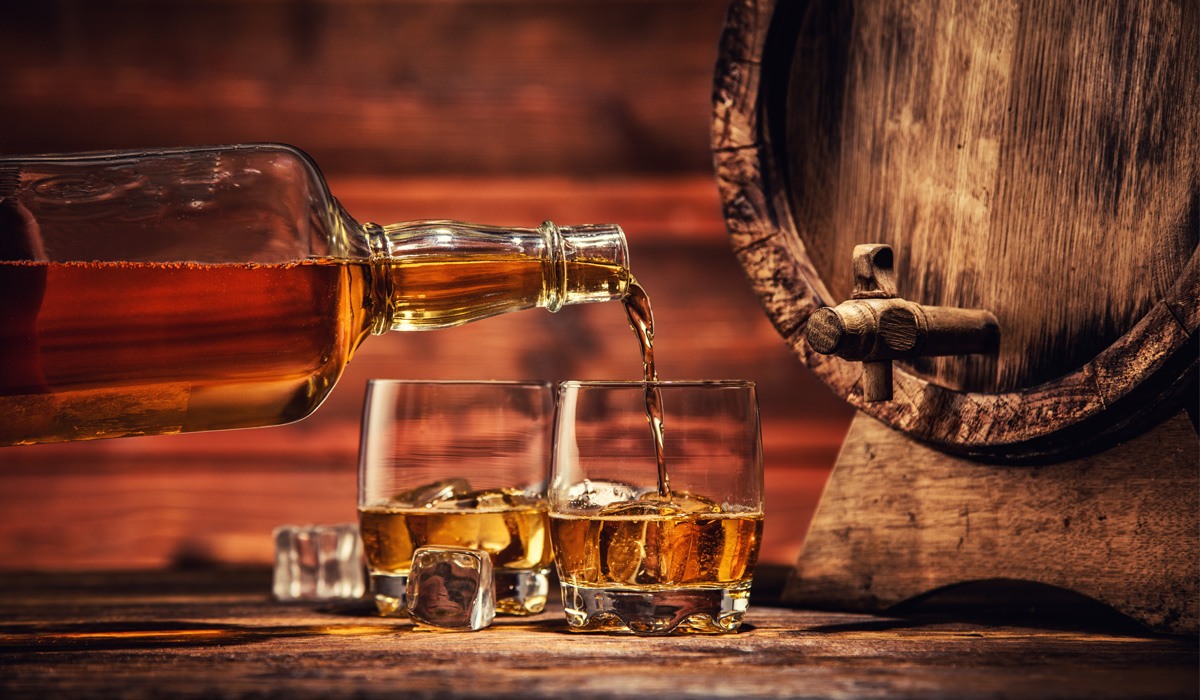
Scotch Whiskey Under $250 FAQ
Does Scotch increase in value with age?
One way to think about value is in terms of delayed gratification. The longer you wait to open a bottle of Scotch, the more rewarding the experience of sharing it with friends and family becomes.
In terms of monetary value, it’s a basic supply and demand equation. Try to think about it with the pragmatism of an investor (which, I’ll point out, is the antithesis of the reason for getting intoxicated). A bottle of Scotch that you can readily find on a shelf in a store will not appreciate over time. Why? Because there is no inverse relationship between supply and demand. Supply will never go down; therefore, demand will never go up. However, rare or collectible Scotches like single cask bottlings, etc., will theoretically appreciate over time due to their limited supply. As supply goes down, demand (theoretically) goes up, and so do prices.
The process for alcohol investment is to buy a bottle, curmudgeon it for as long as you can, then rejoice at some point in the future when you collect on its increased price, which has (ideally) outstripped the inflation rate. Cheers to you.
Does Scotch go bad?
Scotch is alcohol, not milk: age can alter its taste, resulting in perceived deterioration, but it doesn’t become microbially dangerous (any more so than it already was). One technique seems clear: keep your whiskey out of direct sun and heat and minimize its exposure to oxygen to prolong its life. Beyond that, the question of whether Scotch goes “bad” proves difficult to answer, even with the vast, free internet resources amassed by scrupulous drinkers all over the planet.
If you buy a bottle and don’t open it, you can preserve whiskey for longer than you can probably resist drinking it. However, once the bottle is open, the cat’s out of the bag. Store a partial bottle upright to keep the liquid away from the cap or cork. Or decant it (meaning pour, without disturbing the bottom couple inches of liquid) into a smaller bottle to limit oxygen contact and evaporation.
Can you keep Scotch in the fridge?
If you think mixing it with Mountain Dew sounds like a good idea, go ahead and keep your Scotch in the fridge.
How long can you keep an unopened bottle of whiskey?
See our notes on storage and knock yourself out. Temperature, humidity, and sunlight conditions should be stable. Keep in mind that you cannot age whiskey. Unlike wine, Scotch does not continue to change or “mature” inside the bottle, so you cannot increase the age of a whiskey by storing it. Laphroaig 28 is aged 28 years whether you drink it the day you buy it or sit on it for 200 years. Either way, it should taste great.
Should whiskey be kept in the dark?
If not in the dark, at least out of direct sunlight. If you’re confident you’ll finish a partial bottle within a month or two of opening it, dark storage probably isn’t as big of a deal. But sunlight can alter temperature and humidity inside the bottle, causing unintended evaporation and possibly changing the Scotch’s taste.
Sources:
Scotch Whisky – ScienceDirect
Telling Whiskey from Whisky – Physics
Scotch Whisky Regions – The Scotch Whisky Association
